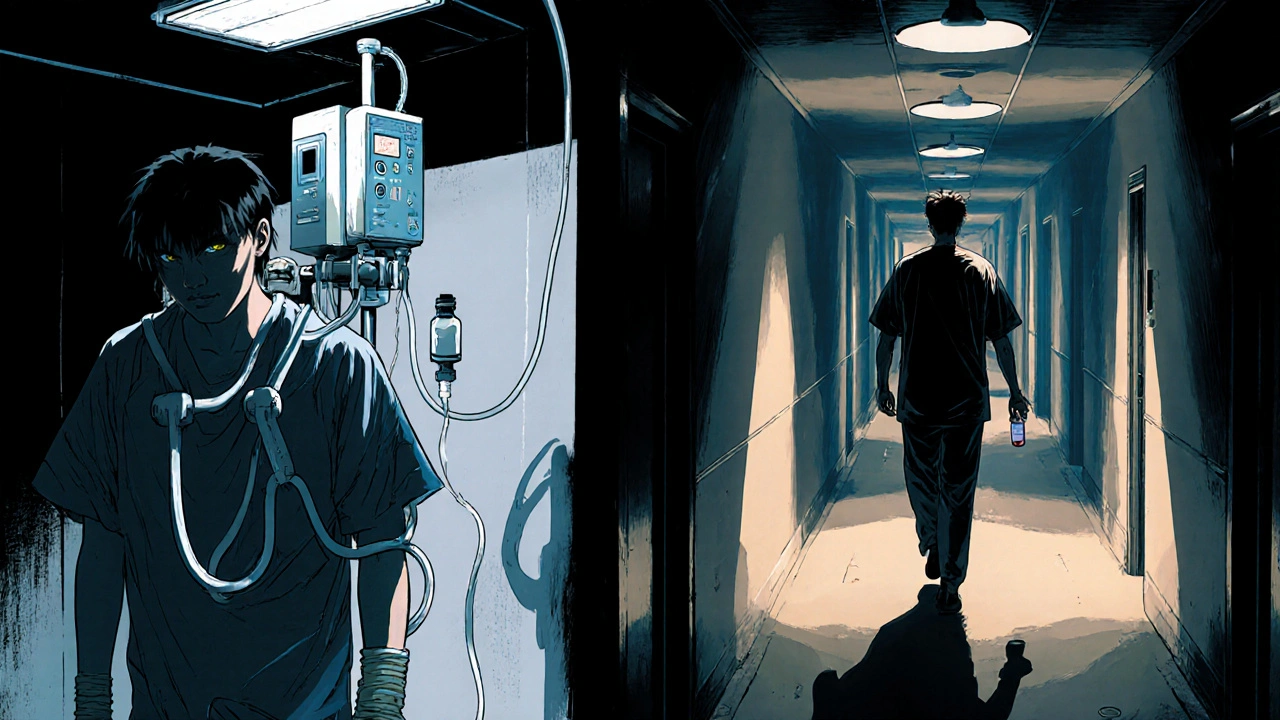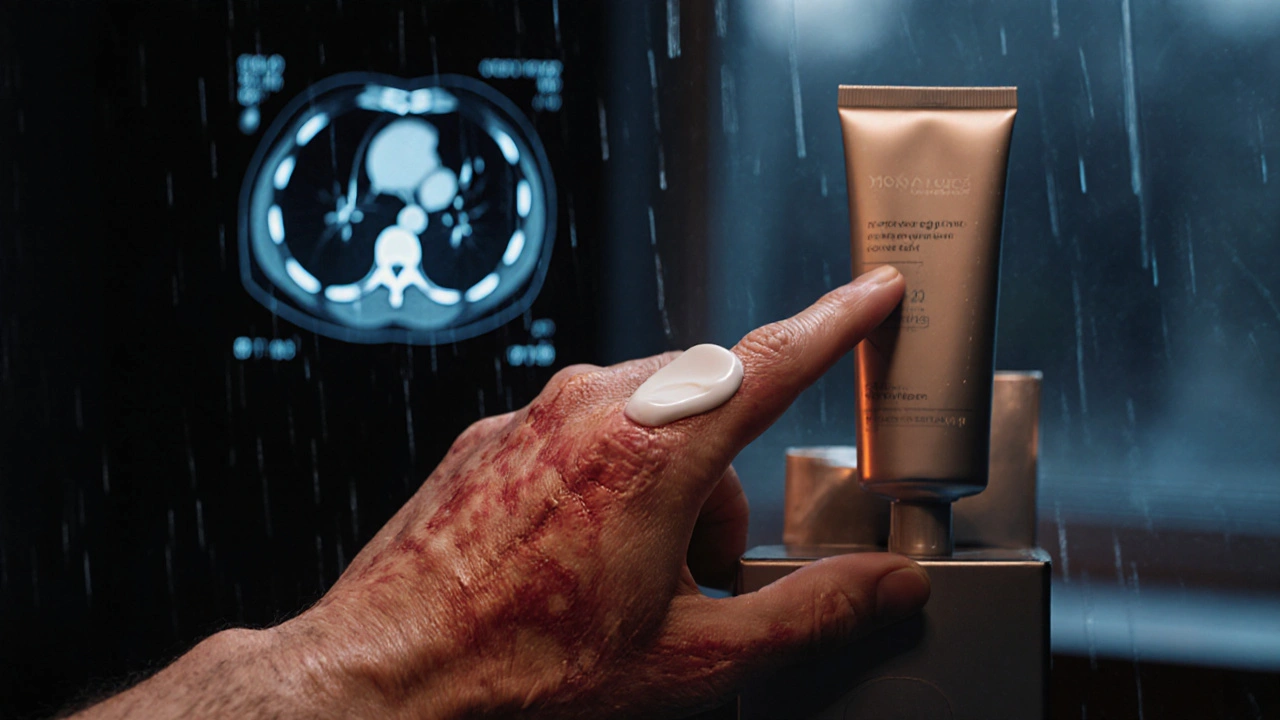When you’re facing cancer treatment, the number of options can feel overwhelming. One drug that comes up often is capecitabine. It’s not the flashy new therapy you hear about in ads, but it’s been quietly changing how people get chemotherapy-especially for breast, colon, and rectal cancers. Unlike traditional chemo that needs an IV drip, capecitabine is a pill you take at home. That alone makes it different from most chemo drugs. But how does it really stack up against others? Let’s break it down without the medical jargon.
What is capecitabine, really?
Capecitabine is an oral chemotherapy drug. It’s not active when you swallow it. Instead, your body converts it into 5-fluorouracil (5-FU)-a chemotherapy agent that’s been around since the 1950s. This conversion happens mostly in cancer cells, which means it targets tumors more precisely than older IV drugs. The result? Less damage to healthy tissue, fewer side effects like hair loss, and the ability to take it at home.
It’s approved by the FDA and TGA (Australia’s Therapeutic Goods Administration) for treating metastatic colorectal cancer, advanced breast cancer, and stage III colon cancer after surgery. In Australia, it’s commonly prescribed under the brand name Xeloda, but generic versions are widely available and covered by the PBS.
How does capecitabine compare to IV chemo like 5-FU?
The biggest difference between capecitabine and intravenous 5-FU is delivery. IV 5-FU requires hospital visits, often for hours at a time, with a pump attached to your arm. Many patients find this disruptive-missing work, childcare, or family time. Capecitabine, taken twice daily for two weeks, then off for one week, fits better into daily life.
A 2021 study in the Journal of Clinical Oncology followed over 1,200 patients with metastatic colorectal cancer. Those on capecitabine had similar survival rates to those on IV 5-FU, but reported better quality of life. They were less likely to need hospital visits for side effects like infections or dehydration.
But it’s not all smooth sailing. Capecitabine can cause hand-foot syndrome-a red, painful, peeling rash on palms and soles. This happens in about 20% of users. IV 5-FU causes this too, but less often. The trade-off? Fewer nausea episodes with capecitabine, but more skin issues.
How does it compare to oxaliplatin and irinotecan?
Oxaliplatin and irinotecan are two other common chemo drugs used alongside or instead of capecitabine. Both are given intravenously and are often combined with 5-FU in regimens like FOLFOX or FOLFIRI.
These combinations are powerful. For advanced colon cancer, FOLFOX (oxaliplatin + 5-FU + leucovorin) can shrink tumors faster than capecitabine alone. But they come with heavy side effects: nerve damage from oxaliplatin (cold sensitivity, tingling fingers), severe diarrhea from irinotecan, and fatigue that lasts for weeks.
Capecitabine is often used as a replacement for 5-FU in these regimens-creating CAPOX or CAPIRI. This switches the delivery from IV to oral, without losing effectiveness. In fact, a 2023 meta-analysis in The Lancet Oncology showed CAPOX had similar tumor control to FOLFOX but with fewer hospitalizations and better patient satisfaction.
What about newer targeted therapies and immunotherapies?
It’s easy to think newer equals better. Drugs like cetuximab, bevacizumab, or pembrolizumab are often talked about as breakthroughs. But they don’t work for everyone. They’re only effective if your tumor has specific genetic markers-like RAS wild-type for cetuximab or MSI-H for pembrolizumab.
Capecitabine doesn’t need genetic testing. It works for most patients with colorectal or breast cancer, regardless of biomarkers. That makes it a reliable backbone treatment. Many oncologists start with capecitabine, then add targeted drugs only if the cancer progresses or if testing shows it’s likely to help.
Immunotherapies like Keytruda (pembrolizumab) can be game-changers-but only for about 5% of colorectal cancer patients. For the rest, capecitabine remains a standard, effective option.

Side effects: What to expect
Every chemo drug has side effects. Here’s how capecitabine compares:
- Hand-foot syndrome: Most common with capecitabine. Starts as tingling, then redness, peeling. Managed with moisturizers, avoiding heat, and sometimes dose reduction.
- Nausea and vomiting: Less than with IV chemo. Usually mild. Anti-nausea pills help.
- Diarrhea: Happens in about 15% of users. More common with irinotecan.
- Low blood counts: Less severe than with oxaliplatin or doxorubicin. Still monitored with regular blood tests.
- Hair loss: Rare. Unlike many chemo drugs, capecitabine usually doesn’t cause it.
One thing many patients don’t expect: mouth sores. Capecitabine can cause them, especially if you’re not drinking enough water. Staying hydrated is one of the simplest, most effective ways to reduce this side effect.
Who benefits most from capecitabine?
It’s not for everyone. But it’s a top choice for:
- People who want to avoid frequent hospital visits
- Those with mobility issues or who live far from treatment centers
- Patients who’ve had bad reactions to IV chemo
- Older adults who need gentler, manageable treatment
- People with stage III colon cancer after surgery (it reduces recurrence risk by up to 30%)
It’s less ideal if you have severe kidney problems, liver disease, or are already on other drugs that interact with it. Your oncologist will check your blood work and medical history before prescribing it.
Cost and access in Australia
In Australia, capecitabine is listed on the Pharmaceutical Benefits Scheme (PBS). That means if you have a Medicare card, you pay the subsidized price-around $30 per script for concession holders, $15 for pensioners. Without PBS, the cost can be over $1,500 per month.
Generic versions are just as effective as Xeloda. Many pharmacies stock them, and your oncologist can prescribe them directly. Insurance doesn’t usually cover extra costs unless you’re on a private plan with chemo coverage.

Real-world experience: What patients say
One patient from Perth, Margaret, 68, was treated for stage III rectal cancer with CAPOX after surgery. She said: "I took the pills at the kitchen table while making tea. I didn’t miss my granddaughter’s birthday. The hand-foot thing was rough, but I learned to wear gloves in the shower and put on cream before bed. I’d do it again. I didn’t feel like I was in treatment-I felt like I was living."
Another, David, 52, with metastatic colon cancer, switched from FOLFOX to CAPOX after two rounds. "The IV pump was exhausting. I was tired all the time. With capecitabine, I had energy for walks. My side effects were different, but easier to manage."
What to ask your oncologist
If you’re considering capecitabine, here are five questions to ask:
- Is capecitabine the right choice for my cancer type and stage?
- Will I need to combine it with other drugs? If so, which ones?
- What are the signs I should call you about right away?
- How will you monitor my kidney and liver function during treatment?
- Are there generic versions available? Can we use them?
Don’t be afraid to ask about alternatives. Sometimes, the best treatment isn’t the most aggressive-it’s the one you can stick with.
Final thoughts
Capecitabine isn’t a miracle drug. It doesn’t cure cancer. But it’s one of the most practical, well-studied oral chemotherapy options we have. It gives people back control over their time, their routines, and their dignity during treatment. Compared to older IV chemo, it’s more convenient. Compared to newer targeted drugs, it’s more universally effective.
For many, it’s not about finding the "best" chemo. It’s about finding the one that lets you live as normally as possible while fighting the disease. That’s where capecitabine shines.
Is capecitabine considered oral chemotherapy?
Yes, capecitabine is an oral chemotherapy drug. You take it as a pill twice a day, usually for two weeks, followed by a one-week break. This makes it different from most traditional chemo drugs that require IV infusions in a hospital or clinic.
Does capecitabine cause hair loss?
Hair loss is rare with capecitabine. Unlike many IV chemotherapy drugs, it doesn’t typically affect hair follicles. Most patients keep their hair, which is one reason many choose it over other treatments.
How long does it take for capecitabine to work?
It doesn’t work immediately. Tumor shrinkage or stabilization usually takes 6 to 12 weeks. Your doctor will monitor progress with CT scans or blood tests. Even if you don’t feel different, the drug is working at the cellular level.
Can I drink alcohol while taking capecitabine?
It’s best to avoid alcohol. It can increase the risk of liver toxicity and worsen side effects like dehydration and mouth sores. Even small amounts can interfere with how your body processes the drug. Always check with your oncologist before drinking.
What should I do if I miss a dose?
If you miss a dose, skip it and take your next dose at the regular time. Don’t double up. Taking too much can increase side effects like diarrhea or hand-foot syndrome. If you miss more than one dose, contact your oncology team right away.
Is capecitabine safe for older adults?
Yes, it’s often preferred for older patients because it’s easier to manage at home and has fewer severe side effects than IV chemo. However, kidney function must be checked regularly, as older adults are more likely to have reduced kidney clearance. Dose adjustments are common and safe.
Can capecitabine be used with radiation therapy?
Yes, it’s often combined with radiation for rectal and some breast cancers. This combination, called chemoradiation, helps shrink tumors before surgery. Capecitabine enhances the effect of radiation without adding much extra toxicity compared to other chemo drugs.

14 Comments
Ryan Masuga November 4 2025
Just finished my third cycle of capecitabine and honestly? It’s been life-changing. No more sitting in a hospital chair for hours. I take my pills with coffee, walk the dog, and still see my grandkids. Hand-foot syndrome? Yeah, it’s a thing-but coconut oil and loose socks saved me. I’d pick this over IV chemo any day.
William Priest November 4 2025
Ugh, another post glorifying oral chemo like it’s some kind of wellness trend. Look, 5-FU has been around since Nixon was president and it works. Capecitabine? It’s just a fancy pill version with a higher risk of hand-foot syndrome and zero novelty. If you’re gonna treat cancer, treat it right-not like you’re ordering a latte.
Jennifer Bedrosian November 6 2025
OMG I’m crying reading this. My mom did capecitabine after surgery and she didn’t lose her hair and she still baked her famous apple pie every weekend. Like… how is that even fair? Cancer tried to take her and she just said ‘not today’ and took her pills at the kitchen table with her cat on her lap. I love this drug. I love this post. I love humanity.
Lashonda Rene November 7 2025
I know people say it’s not a miracle drug but honestly after watching my uncle go through FOLFOX and then switch to CAPOX I just want everyone to know that sometimes the quiet option is the one that lets you live. He was tired but he could still sit outside and watch the birds. He could still talk to his grandkids without being hooked to a pump. It’s not about being the strongest or the newest. It’s about being able to still be you. And that’s huge.
Rashmi Mohapatra November 8 2025
Why do Americans always act like oral chemo is some revolutionary thing? In India we’ve been using oral chemo for decades. Capecitabine is fine but don’t act like you invented convenience. Also why is everyone ignoring the fact that it’s not for everyone? My cousin got severe diarrhea and had to stop. It’s not magic, it’s medicine.
Abigail Chrisma November 9 2025
As someone who’s helped three family members through chemo, I’ve seen the toll IV treatments take-not just physically but emotionally. The ability to stay home, to be in your own space, to keep routines? That’s not a small thing. It’s dignity. And capecitabine gives that back. Not everyone needs the flashiest option. Sometimes the most powerful thing is just being able to breathe.
Ankit Yadav November 10 2025
For me the real win is knowing I can travel. I went to visit my sister in Canada last winter. Took my pills in my hotel room. No IV lines. No clinic appointments. No one asking if I’m ‘feeling okay’ every time I walk into a room. That freedom? Priceless. Capecitabine didn’t cure me but it let me live while I fought.
Meghan Rose November 11 2025
Okay but have you actually read the full FDA label? Because I did. And the warnings about liver toxicity and diarrhea are serious. And why is everyone acting like hand-foot syndrome is just a ‘little rash’? It’s excruciating. You can’t grip a coffee cup. You can’t walk barefoot. This post feels like an ad. Not everyone gets to be Margaret from Perth. Some of us suffer silently.
Steve Phillips November 12 2025
Ohhhhh, so now we’re romanticizing oral chemo like it’s some kind of artisanal, small-batch, farm-to-table cancer treatment?? 🙄 I mean, sure, it’s convenient-but let’s not pretend it’s less toxic. It’s just a different flavor of suffering. And don’t get me started on the fact that 20% of people get that awful hand-foot syndrome that makes your palms look like they’ve been dipped in boiling wax. This isn’t ‘living your best life’-it’s managing side effects like a full-time job.
Rachel Puno November 12 2025
If you’re reading this and you’re scared? I get it. I was too. But take it one pill at a time. Talk to your nurse. Ask about moisturizers for your hands. Drink water. You’re not alone. And even on the hard days, you’re still winning. Just by showing up.
Clyde Verdin Jr November 12 2025
LOL. Everyone’s acting like capecitabine is the holy grail. What about the people who get neutropenia? Or the ones who can’t afford the generic because their insurance won’t cover it? Or the ones who live in rural areas and still have to drive 2 hours for bloodwork? This post is so tone-deaf it’s embarrassing. It’s not ‘living’-it’s surviving with a side of bureaucracy.
Key Davis November 13 2025
While the convenience of oral chemotherapy is undeniably advantageous from a patient-centered care perspective, it is imperative to acknowledge that the pharmacokinetic variability of capecitabine necessitates strict adherence and frequent monitoring. The metabolic conversion to 5-FU is subject to inter-individual differences in carboxylesterase activity, which may impact therapeutic efficacy. Therefore, while the qualitative benefits are significant, clinical decision-making must remain evidence-based and individualized.
Cris Ceceris November 15 2025
It’s funny how we think of medicine as just chemicals and schedules. But what this drug really does? It gives you back moments. The quiet ones. Making tea. Watching the rain. Talking to someone without being tired. It doesn’t fix everything. But it lets you be human again. And maybe that’s the real treatment.
Ryan Masuga November 17 2025
My oncologist said the same thing about the liver enzymes. I get it. But I also know I’m alive because I didn’t have to spend half my life in a hospital. I’d take the hand-foot over the IV pump any day. We’re all just trying to survive on our own terms.